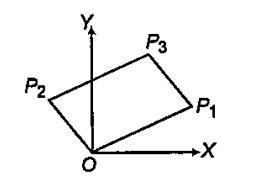Let O, A, B be three collinear points such that OA.OB=1. If O and B represent the complex numbers O and z, then A represents
1z
¯z
1¯z
none of these
The correct Answer is:C
Let the affix of A be z1. Then,
OA.OB=1⇒|z||z1|=1⇒|z1|=1|z|
Clearly, arg(z1)=arg(z)=0 (say)
∴z1=1|z|(cos+isinθ) [∴|z1|=1|z|]
⇒z1=1|z|2(|z|(cos+isinθ)}
⇒z1=1|z|2z=zz¯z=1z
Topper's Solved these Questions
- COMPLEX NUMBERS BOOK - OBJECTIVE RD SHARMACHAPTER - COMPLEX NUMBERS EXERCISE - Section II - Assertion Reason Type
15 Videos
- COMPLEX NUMBERS BOOK - OBJECTIVE RD SHARMACHAPTER - COMPLEX NUMBERS EXERCISE - Exercise
131 Videos
- COMPLEX NUMBERS BOOK - OBJECTIVE RD SHARMACHAPTER - COMPLEX NUMBERS EXERCISE - Chapter Test
59 Videos
- CIRCLESBOOK - OBJECTIVE RD SHARMACHAPTER - CIRCLESEXERCISE - Chapter Test
55 Videos
- CONTINUITY AND DIFFERENTIABILITYBOOK - OBJECTIVE RD SHARMACHAPTER - CONTINUITY AND DIFFERENTIABILITYEXERCISE - Exercise
86 Videos
Similar Questions
Knowledge Check
Let OP.OQ=1 and let O,P and Q be three collinear points. If O and Q represent the complex numbers of origin and z respectively, then P represents
A1zB¯zC1¯zD−zLet A,B,C be three collinear points which are such that AB.AC=1 and the points are represented in the Argand plane by the complex numbers, 0, z1 and z2 respectively. Then,
Az1z2=1Bz1¯z2=1C|z1||z2|=1Dz1=¯z2∣In a given parallelogram, if the points P1 and P2 represent two complex numbers z1 and z2, then the point P3 represents the number
 Az1+z2Bz1−z2Cz1×z2Dz1+z2
Az1+z2Bz1−z2Cz1×z2Dz1+z2
Let A,B, C,D be four concyclic points in order in which AD:AB=CD: CB. If A,B,C are representing by complex numbers a,b,c respectively find the complex number associated with point D.
View SolutionConsider the circle: x2+y2=r2 with centre O.AandB are collinear with O such that OA.OB=r2. The number of circles passing through A and B, which are orthogonal to the circle C is
View SolutionLet a, b, c be distinct complex numbers with |a|=|b|=|c|=1 and z1, z2 be the roots of the equation az2+bz+c=0 with |z1|=1. Let P and Q represent the complex numbers z1 and z2 in the Argand plane with ∠POQ=θ, o∘<180∘ (where O being the origin).Then
View SolutionPoint P represent the complex number z=x+iy and point Q represents the complex number z+1z. If P moves on the circle |z|=2, then the eccentricity of locus of point Q is
View SolutionIf z≠1 and z2z−1 is real, the point represented by the complex numbers z lies
View Solution
